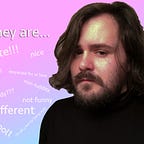I Only Know What Brad Garrett Looks Like from Sitcom Angles
How I learned to love Brad without Ray.
I started watching NBC’s This is Us a few weeks ago during what could only be described as a drug-fueled craving for media I could zone out to yet enjoy. The show proved to be a successful combatant against what was otherwise an opportunity for thoughts to turn to mush, my day into one long nap.
It’s not a perfect show. Not by any means. But rather than argue for the integrity of a program that I’d call porn for your emotions, I’m going to bring up a thought that came together during my viewing session, a thought that really seemed to bother me in the way something like this would if you were as out of it as I was.
While I was watching the show, around the second episode (or maybe sooner), I realized:
I’ve never seen Brad Garrett’s face.
Now this isn’t entirely true. I used to watch Everybody Loves Raymond back when it was regularly syndicated on UPN and TBS almost nightly with my parents. I could never forget Garrett’s performance as Robert, the whiney brother who was always jealous of his parents’ love for his brother.
I mean, if we’re being honest, Robert was probably the only character I was ever invested in. Ray always came across as boring or insincere and the other characters felt less like human beings than one-line joke machines. Robert grounded the show with this weird semblance of pathos that’s missing from other soulless situational comedies.
But can I really say I knew Brad Garrett’s face?
Sure, I’ve watched his figure lurk from one side of the screen to the next between a three camera setup hundreds of times. But is that a real look at a person? Can you really know what a person looks like without viewing their features in a portrait frame?
It’s now that I’m reminded of The Big Bang Theory and Jim Parson’s ongoing success. This year he appeared in Hidden Figures in a role that felt more human than the bazinga-spewing abomination that is Sheldon Cooper.
Yet, for some reason, when I viewed his face in a single camera setup, I was not given the same reaction. He felt familiar. His face was understood.
I could presume that this lack of reaction might be on the part of the drugs I had consumed prior to my Garrett revelation. I’m probably right in assuming this had a part to play but, at the same time, I’m not entirely convinced.
There’s something here. Something to this.
Garrett is not the sellout that Parsons has become.
Simple as that.
He has retained some semblance of artistic sensibility in the roles he selects. When he decided to cash in he did so off-screen through voice over work. When Raymond was getting dull, he gave his character an arc and continued to evolve as the one emotional force in an otherwise dry house (with the exception of Peter Boyle and Doris Roberts’ moments).
He felt real.
So when I saw his face shadowed in the poor mumblecore-esque lighting of This is Us, I was shocked to take in his full frame. His signature height was of no surprise compared to the wrinkles he sports, the laugh lines he hangs. Brad Garrett is visually older in this view. His face is more complex.
For this reason, I had trouble identifying him, thinking, Wow, that guy looks like Brad Garrett and I wonder what Brad Garrett is up to right now. Little did I know the answer was staring me in the face the whole time. I was just too blinded to see.
I’m reminded of a really great book about the conversion of society into image, the ongoing commodification of our sacred experiences.
Guy Debord’s The Society of the Spectacle addresses how film, television, and modern convention lead us to overlook things that once mattered so much to us. Our media have blinded us into believing that all feelings are mere transgressions phased through light and energy. We do not live so much as we experience.
In applying this to myself, I think part of what shocked me so much with Brad Garrett was the sudden realization that his figure could look so complex. I was surprised to find that he could be real.
I did not sexually consume his image but, in a way, I had objectified his portrait in that I did not believe I could see him in other frames than that of the situational comedy.
It’s a long-shot, I know… but I feel remorse for painting him this way.
In short, I’m sorry, Brad Garrett.
